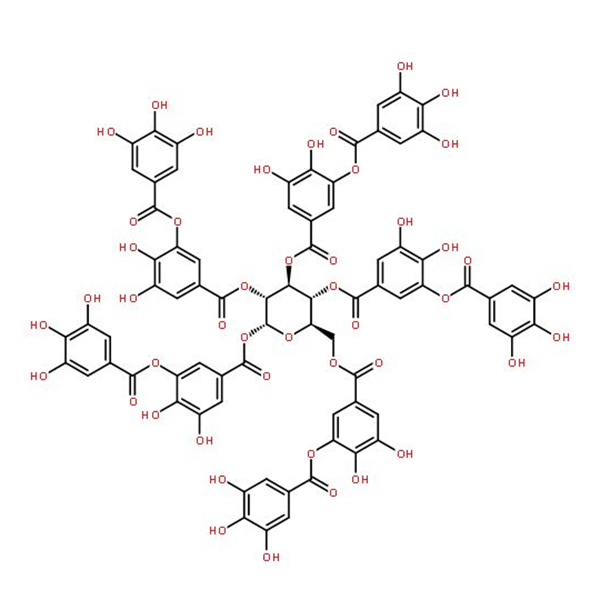
PRODUCTS CENTER
——
Methyl gallate
Product DetailsSpecification DataApplication
Product name: Methyl gallate
Chemical name: Methyl 3,4,5-trihydroxybenzoate.
Structural formula: C₈H₈O₅ / 184.15g/mol
CAS: 99-24-1
Properties: white to slightly beige crystalline powder
| Items | Industrial grade | High-purity grade | Elctronic grade | ||||
| Appearance | White crystal | White crystal | White crystal | ||||
| Assay % | ≥99.0% | 99.93% | 99.95% | ||||
| Gallic aicd % | ≤0.1% | 0.04% | 0.03% | ||||
| Melting point ℃ | 198.0-203.0℃ | 202.0-203.0℃ | 202.0-203.0℃ | ||||
| Loss on dring % | ≤0.5% | 0.07% | 0.06% | ||||
| Lgnition residue % | ≤0.1% | 0.012% | 0.010% | ||||
| Color(APHA) | ≤100 | <100 | <100 | ||||
| trace metal content(ppm) | |||||||
| Fe | ≤0.5 | <0.5 | <0.1 | ||||
| Na | ≤0.5 | <0.5 | <0.1 | ||||
| Mg | ≤0.5 | <0.5 | <0.1 | ||||
| Al | ≤0.5 | <0.5 | <0.1 | ||||
| K | ≤0.5 | <0.5 | <0.1 | ||||
| Mn | ≤0.5 | <0.5 | <0.1 | ||||
| Ni | ≤0.5 | <0.5 | <0.1 | ||||
| Cu | ≤0.5 | <0.5 | <0.1 | ||||
| Zn | ≤0.5 | <0.5 | <0.1 | ||||
| Ca | ≤0.5 | <0.5 | <0.1 | ||||
Methyl gallate, an ester of gallic acid and methanol, has garnered considerable attention for its versatile applications across a wide array of industries, including food, pharmaceuticals, cosmetics, agriculture, and other industrial sectors. This compound possesses a broad spectrum of properties that make it valuable as an antioxidant, preservative, antimicrobial agent, and pharmaceutical intermediate. The expanding recognition of methyl gallate's potential in various fields underscores its importance in both traditional and emerging industries.
Food Industry
In the food industry, methyl gallate is primarily valued for its potent antioxidant properties. Antioxidants are essential in food preservation as they prevent the oxidation of fats, oils, and other food components, which can lead to spoilage, rancidity, and the loss of nutritional value. Methyl gallate, being a natural compound, is increasingly used as a safe and effective antioxidant to prolong the shelf life of food products. It works by scavenging free radicals that contribute to oxidative stress, thus preserving the flavor, color, and overall quality of food.
Methyl gallate’s role in the food industry extends beyond its antioxidant capacity. It also functions as a natural preservative, providing an alternative to synthetic preservatives that may raise concerns among consumers. As consumers become more health-conscious and environmentally aware, there has been a growing demand for natural food additives, and methyl gallate, due to its natural origins, is a suitable candidate for meeting this demand. Its application as a preservative is particularly beneficial in extending the shelf life of processed foods, such as baked goods, sauces, and snacks, while maintaining their safety and quality.
Pharmaceutical Industry
In the pharmaceutical industry, methyl gallate is utilized as an important pharmaceutical intermediate, particularly in the synthesis of various therapeutic compounds. One key example is its use in the preparation of biphenyl dibenzoate, a compound with applications in treating various medical conditions. Methyl gallate's ability to undergo chemical transformations makes it a valuable building block for the development of more complex pharmaceutical molecules. This capacity for chemical versatility opens up numerous avenues for the development of new drugs targeting a wide range of ailments.
Moreover, methyl gallate itself is gaining attention for its potential in drug development, particularly in the treatment of osteoarthritis. Osteoarthritis is a common degenerative joint disease that causes pain, stiffness, and reduced mobility, and current treatments primarily focus on symptom management rather than addressing the root causes of the disease. Preliminary studies suggest that methyl gallate possesses anti-inflammatory and antioxidant properties, which could potentially help reduce the inflammation and oxidative stress associated with osteoarthritis. Its ability to modulate inflammatory pathways makes it a promising candidate for the development of novel therapeutic agents aimed at improving the quality of life for individuals suffering from this debilitating condition.
Beyond its direct use in drug formulation, methyl gallate also plays an essential role as an excipient in pharmaceutical preparations. As an excipient, it can serve various functions such as a stabilizer, solubilizer, or antioxidant, ensuring the stability and effectiveness of the final pharmaceutical product. In many drug formulations, especially those in liquid form, methyl gallate can enhance the solubility of active ingredients, thereby improving their bioavailability and therapeutic efficacy. Furthermore, its antioxidant properties help prevent the degradation of sensitive compounds, ensuring that drugs remain potent and effective over time.
Cosmetics Industry
The cosmetics industry has also recognized the value of methyl gallate, particularly for its antioxidant and anti-aging properties. As an antioxidant, methyl gallate plays a crucial role in protecting the skin from oxidative stress, which is a significant factor in the aging process. Free radicals, which are highly reactive molecules produced by environmental factors such as UV radiation and pollution, can damage skin cells and accelerate the formation of wrinkles, fine lines, and other signs of aging. By neutralizing these free radicals, methyl gallate helps to protect the skin from this damage, thereby contributing to healthier, more youthful-looking skin.
In addition to its antioxidant benefits, methyl gallate is used in various cosmetic formulations to help maintain skin health. Its inclusion in anti-aging creams, serums, and lotions helps improve the skin’s elasticity, reduces the appearance of wrinkles, and combats other visible signs of aging. Furthermore, its anti-inflammatory properties can soothe irritated skin, making it a beneficial ingredient for sensitive skin formulations. The growing consumer demand for natural and effective skincare products has led to the increased incorporation of methyl gallate into cosmetic products, reinforcing its reputation as a valuable component in modern skincare.
Agriculture
Methyl gallate also has a promising future in agriculture, particularly due to its antimicrobial properties. Plant diseases caused by bacteria, fungi, and viruses are a major concern for farmers, as they can reduce crop yields and affect food security. Methyl gallate’s ability to combat plant pathogens positions it as a potential solution for reducing the incidence of crop diseases. By inhibiting the growth of harmful microorganisms, methyl gallate helps protect crops from infections that can lead to significant losses.
Its antifungal properties, in particular, make methyl gallate useful in controlling fungal infections in plants. Fungal diseases, such as mildew and rust, are common threats to a wide range of crops, including fruits, vegetables, and grains. The application of methyl gallate as a natural fungicide can help reduce the need for synthetic chemical fungicides, which are often harmful to the environment and human health. By providing a safer alternative, methyl gallate contributes to more sustainable farming practices, supporting the growing trend towards organic and eco-friendly agriculture.
Moreover, methyl gallate’s role in agriculture is not limited to its use as an antimicrobial agent. Its potential as a plant growth regulator is also being explored. Similar to other plant growth regulators, methyl gallate could help enhance crop yields, improve plant resistance to environmental stressors, and optimize the overall growth of crops. This aspect of its application could be particularly important in addressing challenges such as climate change and resource scarcity, where improving crop resilience is crucial.
Other Industrial Applications
Beyond its use in the food, pharmaceutical, cosmetic, and agricultural sectors, methyl gallate also finds applications in other industrial fields. One notable example is its use as a rubber antioxidant. Methyl gallate helps improve the aging resistance of rubber products, extending their service life and maintaining their performance in demanding environments. Rubber is widely used in the manufacturing of tires, seals, gaskets, and various other products that require durability and long-term functionality. By incorporating methyl gallate as an antioxidant, manufacturers can enhance the longevity of these products and reduce the need for frequent replacements.
Keyword: Methyl gallate
Prev: Gallic acid
Next: Propyl gallate
Product Inquiry
Related Products
Products
-

Gallic acid
Chemical name : 3,4,5-trihydroxybenzoic acid. Molecular formula:C₇H₆O₅ CAS: 149-91-7 It can be widely found in the nature, such as Rheum Palmatum, Swamp Mahogany, dogwood, etc. Gallic acid is widely applied in multiple fields such as food, biology, pharmaceutical, chemical industry, semiconductor, etc.
-

Methyl gallate
Chemical name : 3,4,5-trihydroxybenzoate. CAS:99-24-1; Chemical formula:C₈H₈O₅. It is widely applied in multiple fields such as food, biology, pharmaceutical, chemical industry, semiconductor, etc.
-

Propyl gallate
Chemical name: 3,4,5-trihydroxybenzoate. CAS:121-79-9; Molecular formula : C₁₀H₁₂O₅. It is used as an antioxidant additive in industries like food pharmaceutical, cosmetic, hair care product, feed and semiconductor; and as a stabilizer in manufacturing of green fiber and a rubber antioxidant.
-

Pyrogallol
Pyrogallol is also called pyrogallic acid. Chemical name: 1,2,3-trihydroxy benzene. CAS:87-66-1 Molecular formula :C₆H₆O₃. It is obtained by decarboxylic reaction of gallic acid.
-

Tannic acid
Tannic acid also called tannin is an organic compound. CAS:1401-55-4 Chemical formula: C₇₆H₅₂O₄₆. Tannic acid can be used for making gallic acid.

